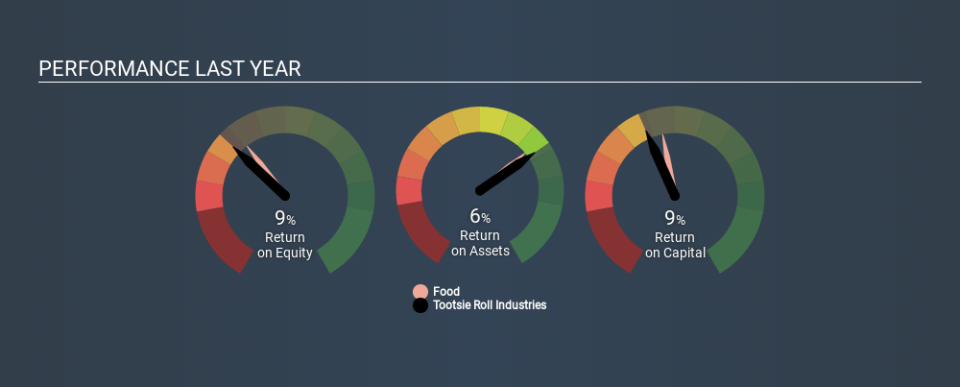Don’t Buy Tootsie Roll Industries, Inc. (NYSE:TR) Until You Understand Its ROCE

Today we'll evaluate Tootsie Roll Industries, Inc. (NYSE:TR) to determine whether it could have potential as an investment idea. To be precise, we'll consider its Return On Capital Employed (ROCE), as that will inform our view of the quality of the business.
First of all, we'll work out how to calculate ROCE. Next, we'll compare it to others in its industry. Last but not least, we'll look at what impact its current liabilities have on its ROCE.
Understanding Return On Capital Employed (ROCE)
ROCE measures the amount of pre-tax profits a company can generate from the capital employed in its business. All else being equal, a better business will have a higher ROCE. Ultimately, it is a useful but imperfect metric. Author Edwin Whiting says to be careful when comparing the ROCE of different businesses, since 'No two businesses are exactly alike.
So, How Do We Calculate ROCE?
The formula for calculating the return on capital employed is:
Return on Capital Employed = Earnings Before Interest and Tax (EBIT) ÷ (Total Assets - Current Liabilities)
Or for Tootsie Roll Industries:
0.091 = US$82m ÷ (US$978m - US$80m) (Based on the trailing twelve months to December 2019.)
Therefore, Tootsie Roll Industries has an ROCE of 9.1%.
See our latest analysis for Tootsie Roll Industries
Is Tootsie Roll Industries's ROCE Good?
When making comparisons between similar businesses, investors may find ROCE useful. It appears that Tootsie Roll Industries's ROCE is fairly close to the Food industry average of 8.9%. Aside from the industry comparison, Tootsie Roll Industries's ROCE is mediocre in absolute terms, considering the risk of investing in stocks versus the safety of a bank account. Investors may wish to consider higher-performing investments.
The image below shows how Tootsie Roll Industries's ROCE compares to its industry, and you can click it to see more detail on its past growth.
Remember that this metric is backwards looking - it shows what has happened in the past, and does not accurately predict the future. ROCE can be deceptive for cyclical businesses, as returns can look incredible in boom times, and terribly low in downturns. ROCE is only a point-in-time measure. You can check if Tootsie Roll Industries has cyclical profits by looking at this free graph of past earnings, revenue and cash flow.
Tootsie Roll Industries's Current Liabilities And Their Impact On Its ROCE
Current liabilities are short term bills and invoices that need to be paid in 12 months or less. The ROCE equation subtracts current liabilities from capital employed, so a company with a lot of current liabilities appears to have less capital employed, and a higher ROCE than otherwise. To counter this, investors can check if a company has high current liabilities relative to total assets.
Tootsie Roll Industries has total assets of US$978m and current liabilities of US$80m. As a result, its current liabilities are equal to approximately 8.1% of its total assets. With low levels of current liabilities, at least Tootsie Roll Industries's mediocre ROCE is not unduly boosted.
Our Take On Tootsie Roll Industries's ROCE
Based on this information, Tootsie Roll Industries appears to be a mediocre business. You might be able to find a better investment than Tootsie Roll Industries. If you want a selection of possible winners, check out this free list of interesting companies that trade on a P/E below 20 (but have proven they can grow earnings).
If you are like me, then you will not want to miss this free list of growing companies that insiders are buying.
If you spot an error that warrants correction, please contact the editor at editorial-team@simplywallst.com. This article by Simply Wall St is general in nature. It does not constitute a recommendation to buy or sell any stock, and does not take account of your objectives, or your financial situation. Simply Wall St has no position in the stocks mentioned.
We aim to bring you long-term focused research analysis driven by fundamental data. Note that our analysis may not factor in the latest price-sensitive company announcements or qualitative material. Thank you for reading.

